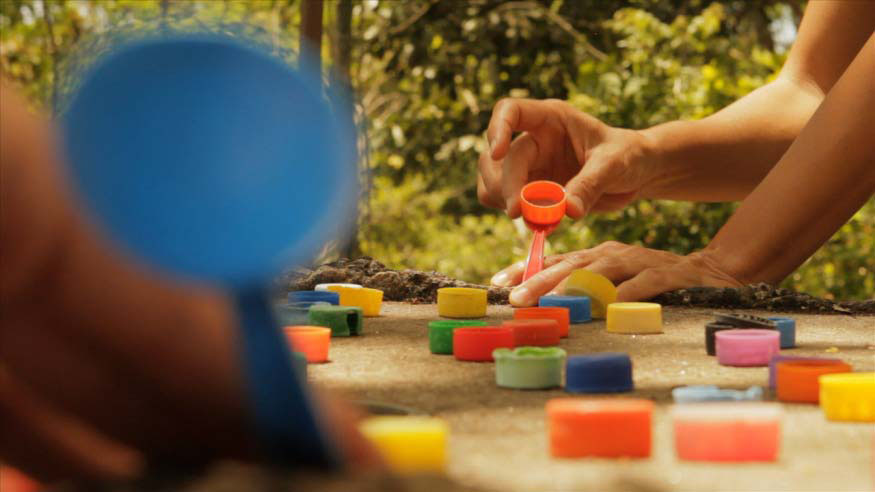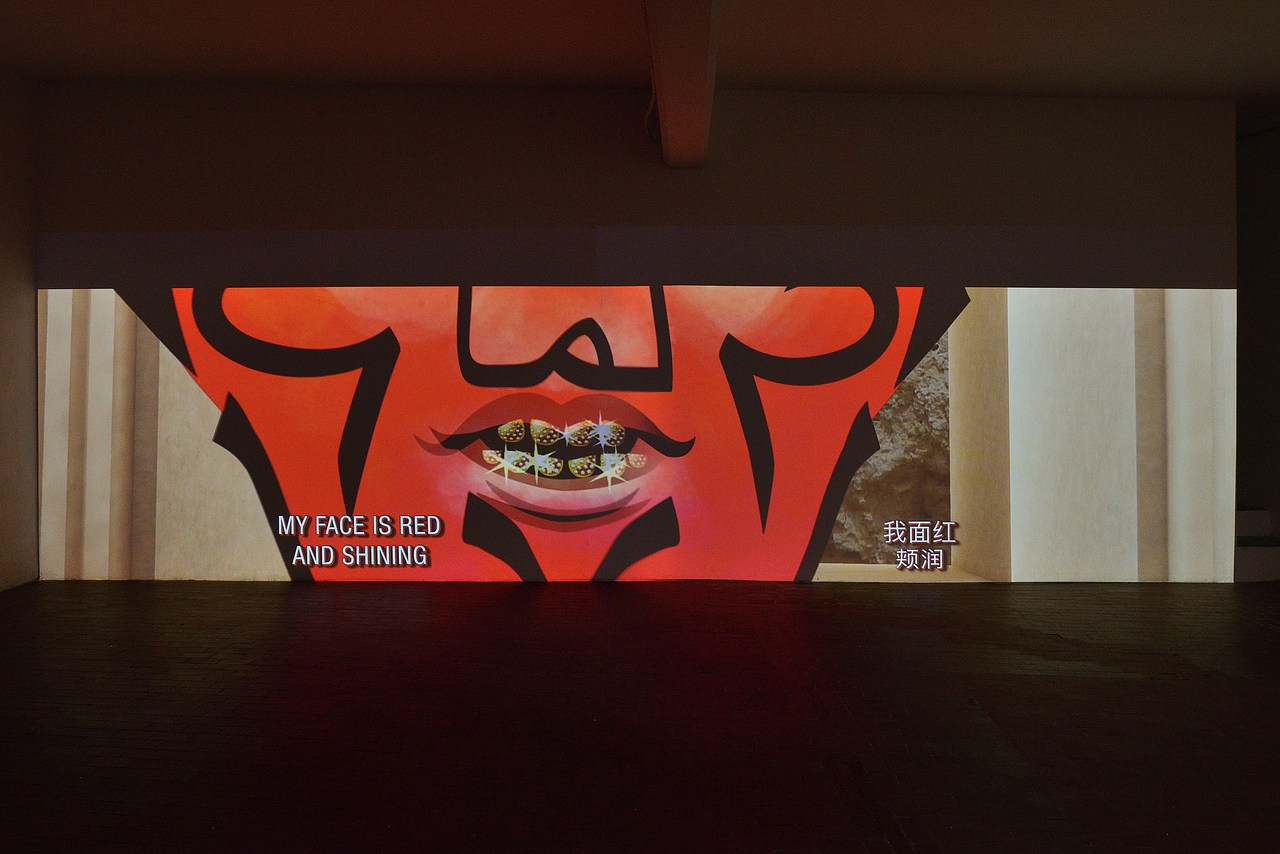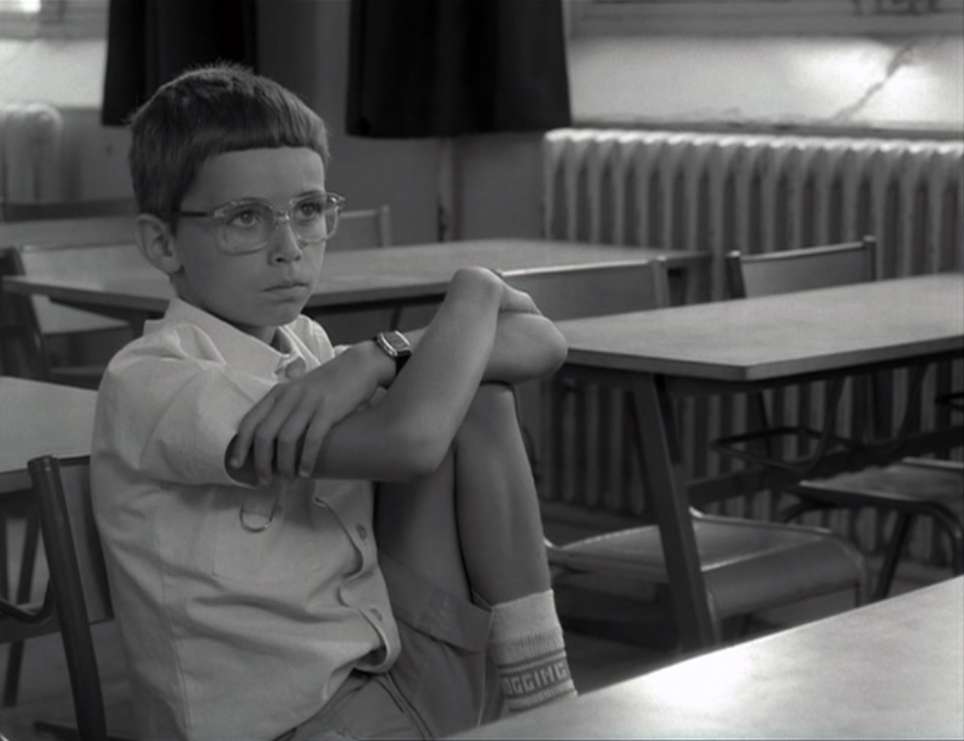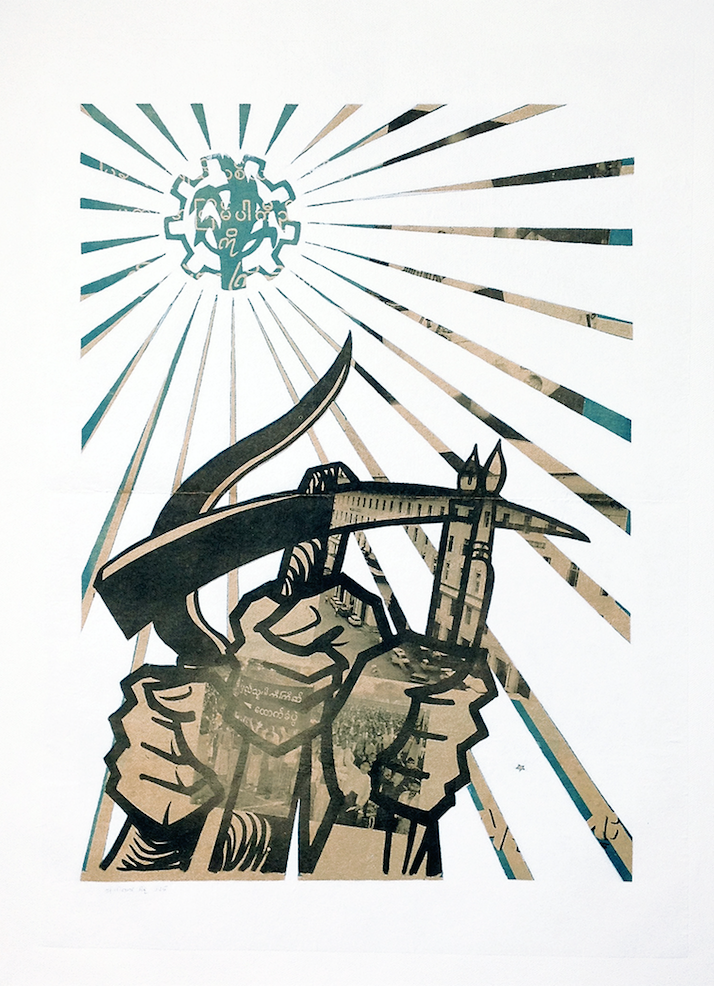
© » KADIST
Jordan Ann Craig
Something To Do With Being Held by Jordan Ann Craig is inspired by a Cheyenne bead bag. Intrigued by the two shades of blue used for the source object (a deep dusty blue and a bold vivid cobalt blue) the artist replicated these shades in her painting. Craig then added in her own colors, including the pink-orange hues, to achieve a bold but soft quality about the work, as she states that she intended the work to convey vulnerability.

© » KADIST
Ana Roldán
Ana Roldán’s Primeval forms series looks up close at the fecund shapes of plants often found in the artist’s native Mexico. These botanical portraits, like this one of the Pseudobombax ellipticum, or shaving brush tree, bristle against the edges of the image’s frame, fecund and wild, familiar yet foreign. Ana Roldán works in diverse media such as performance, sculpture, installations, video and collage.
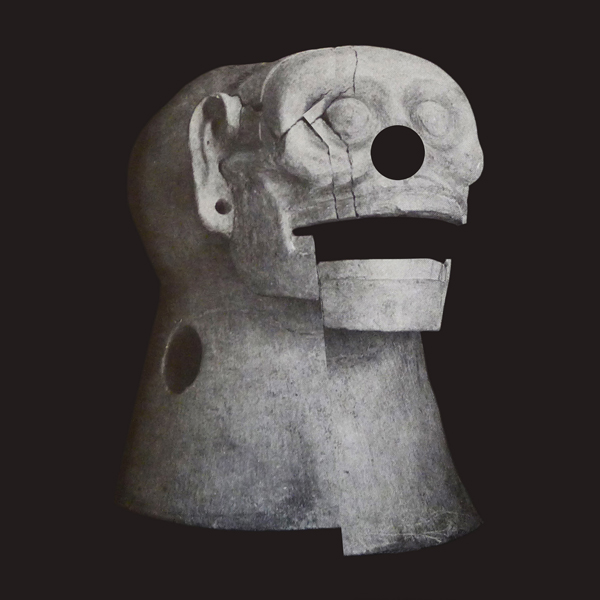
© » KADIST
Ana Roldán
Ana Roldán’s Displacements works use images taken from a 1970s exhibition catalogue for an exhibition called The Death in Mexico. Using pre-Columbian objects and other artifacts from Mexican history, the exhibition aimed to explore various representations of death in the Mexican cultural tradition. Roldán’s works begin with these rich black-and-white photographs and break them apart into fragments, slicing and dismembering the artifacts they depict.

© » KADIST
Jordan Wolfson
Dreaming of the dream of the dream is a 16mm projection consisting of images of waves that come and go continuously. The artist has assembled extracts of cartoons in which water is visible (the sea, bubbles, a stream, waves, etc.). Somewhat nostalgic, these extracts can recall either childhood cartoons or paintings by Hokusai.

© » KADIST
Jordan Kantor
Drawing & Print (Drawing & Print)
Eclipse is a series of screenprints from Jordan Kantor’s larger vitrine installation that included reworkings of a single image of a small group viewing an eclipse through shielding cut-outs. Printed on a clear surface, the work plays with ideas of obstruction and viewing, connecting spectacular natural phenomena with contemporary art making.

© » KADIST
Jordan Kantor
Lens Flare and the series Untitled Basel Lens Flare (6168, 5950, 7497) were part of a solo project by the artist presented at ArtBasel in 2009. Included in the Kadist Collection, these works continue to explore the ontology of the image to investigate the relationship between painting, photography, and a new time-based variable: film. Reduced here to the essential function of recording the exposure of light through the apparatus of a lens, Kantor then translated these film stills into painted colored canvases that retain the 3:4 aspect ratio of the 16mm film as well as the exact size of the projected image.

© » KADIST
Jordan Kantor
Lens Flare and the series Untitled Basel Lens Flare (6168, 5950, 7497) were part of a solo project by the artist presented at ArtBasel in 2009. Included in the Kadist Collection, these works continue to explore the ontology of the image to investigate the relationship between painting, photography, and a new time-based variable: film. Reduced here to the essential function of recording the exposure of light through the apparatus of a lens, Kantor then translated these film stills into painted colored canvases that retain the 3:4 aspect ratio of the 16mm film as well as the exact size of the projected image.

© » KADIST
Douglas Gordon
Blind Spencer is part of the series “Blind Stars” including hundreds of works in which the artist cut out the eyes of Hollywood stars, in a symbolically violent manner. An emptiness (some are burned letting appear a white or mirror background or a mirror) replaces the eyes, giving the impression of a blind eye deprived of all expression. Paradoxically, the work looks at us all the more intensely.

© » KADIST
Douglas Gordon
Douglas Gordon’s single-channel video The Left Hand Can’t See That The Right Hand is Blind, captures an unfolding scene between two hands in leather gloves—at first seemingly comfortable to be entwined, and later, engaged in a struggle. As suggested by the work’s title, each of the hands assumes a character with a distinct personality, as if we were witnessing a lovers’ quarrel and embrace, or the embodiment of opposing forces of an internal struggle. Gordon has previously created performance-based works depicting his own body or parts of it—arms, hands, fingers, eyes—usually enacting simple, repetitive movements.

© » KADIST
Leah Gordon
The Caste Portraits Series by Leah Gordon investigates the practice of grading skin color from black to white, which marked the extent of racial mixing in 18th century Haiti. Médéric Moreau de St Mery (1750-1819), a French créole slave owner and freemason living in Saint Domingue (now Haiti), created a taxonomy of race classifying skin color from black to white using names derived from mythology, natural history, and bestial miscegenation. His Description topographique, physique, civile, politique et historique de la partie française de l’isle Saint-Domingue (1789) hierarchizes 128 possible combinations of black-white miscegenation into nine categories (the sacatra, the griffe, the marabout, the mulâtre, the quarteron, the métis, the mamelouk, the quarteronné, and the sang-melé).
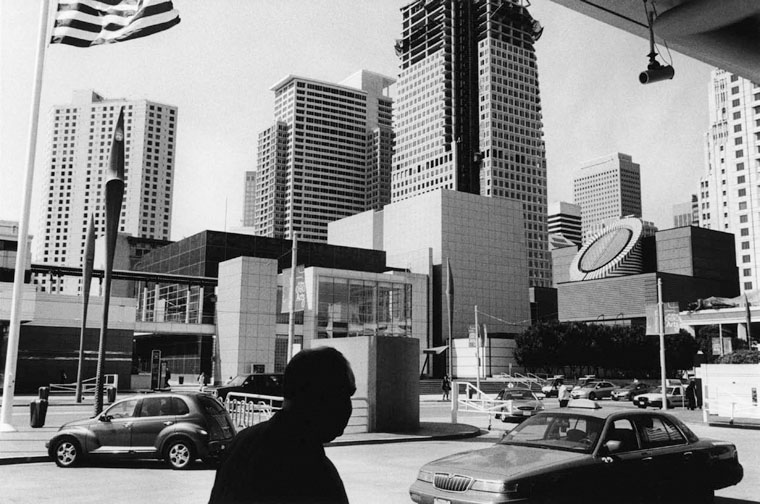
© » KADIST
Richard Gordon
San Francisco, Moscone Center is a silver gelatin print from the series American Surveillance , a ten-year-long project where Richard Gordon photographed surveillance cameras across USA. In the image’s foreground we see the silhouette of a man, darkened and in contrast to the bright streetscape unfolding behind him. To the left, an American flag flutters in the wind, saluting the skyscrapers—among them the iconic architecture of the San Francisco Museum of Modern Art.

© » KADIST
Douglas Gordon
In Monster (1996-97), the artist’s face becomes grotesque through the application of strips of transparent adhesive tape, typical of Gordon’s performance-based films that often depict his own body in action. Also characteristic of his work, the scene takes place in front of a mirror, suggesting the kind of personal self-reflection that one is capable of – both good and evil. The video makes clear cinematographic reference to the ‘alter-ego’ transformation in Mamoulian’s Dr. Jekyll and Mr. Hyde, and to the “You looking at me?” sequence performed in front of a mirror by Robert De Niro in Scorsese’s Taxi Driver which also inspired Gordon’s through a looking glass ( 1999).

© » KADIST
Richard Gordon
Washington D. C. Constitution Ave. is a silver gelatin print from the series American Surveillance , a ten-year-long project where Richard Gordon photographed surveillance cameras across USA. In the image, a woman and a child walk along Constitutional Avenue as a surveillance camera on the street post directs its gaze towards them. The otherwise quiet image then becomes an exercise of resistance: together with the other images from the series, Gordon’s photograph documents the changes that have taken place in architecture, civic life, especially in a post 9/11 experience of public space.

© » KADIST
Andrew Norman Wilson
In Andrew Norman Wilson’s work Kodak the artist uses computer-generated imagery to create narratives that question the reliability of images in the age of post-production. The artist creates disturbances in typical notions of time and space to highlight the existential terror of humans trying to make sense of their memories and perception in the 21st century. On its surface, Kodak questions how improvements in digital imagery have affected the analog film industry, but it also showcases the consequences for how humans relate to their memories.

© » KADIST
Andrew Norman Wilson
Chase ATM emitting blue smoke, Bank of America ATM emitting red smoke, TD Bank ATM emitting green smoke was shot in the American Southwest at Mid-century modern architectural structures that were built to house regional independent banks and have since been bought up by Chase, Bank of America, and TD Bank. The video utilizes transparency and opacity effects in multimedia software to question the perceptibility of finance. It offers a complex metaphor (toxic assets, emergency flares, house/mortgage on fire) about the financial sector and the effects of the ‘crisis’ that led to the disappearance (and the ghostly memory) of many local and regional banks.

© » KADIST
Andrew Norman Wilson
Z = |Z/Z•Z-1 mod 2|-1: Lavender Town Syndrome by Andrew Norman Wilson is a multi-channel video that uses three different imaging technologies—a photographic lens, photorealistic ray tracing animations, and fractal ray-marching animations—to travel through three constructed environments. The work’s subtitle, Lavender Town Syndrome, is named for a conspiracy theory in which more than 200 Japanese children were driven to suicide by a particular board in the game Pokémon Red and Green for Game Boy. Many others suffered serious migraines or nosebleeds, or turned violent when their parents tried to take the game away.

© » KADIST
Andrew Norman Wilson
On the first day of the Covid-19 lockdown in New York, Andrew Norman Wilson was evicted from his sublet and decided to board a $30 flight to Los Angeles that evening. From a cottage that faces the Hollywood sign, he began to dwell on an encounter he had with a woman driving alongside him on the highway, emphatically singing along to the song he was listening to through the same radio station. That song was Phil Collins’s “In the Air Tonight.” For Wilson, the uncanny synchronicity of this encounter with a stranger tuned into the same frequency resonated with the inspiration for Phil’s song, which he first heard as a teenager while getting high in a friend’s basement.

© » KADIST
Mary Ann Aitken
Untitled (Boom Box, Double-Sided) by Mary Ann Aitken is representational painting of a boom box on an unconventionally long canvas painted on both sides, to mimic the scale and appearance of the actual appliance. Known for going against trends, Aitken often favored dimensions, such as the square, that were otherwise considered out of style in contemporary painting. In this double-sided painting, one side depicts the titular boombox set up—a boxy cassette player, flanked by a pair of stereo speakers in front of wood panelling.

© » KADIST
Mary Ann Aitken
Untitled (Diptych) by Mary Ann Aitken is a pair of paintings; one entirely abstract and the other a hybrid of representational and abstract elements. The left-side painting is a cacaphonous all over composition of brushstrokes layered in the artist’s signature primary colors. In the same color scheme, the right-side painting portrays a still life with an arrangement of flowers as its focal point, with marks and splatter spilling from the left-side composition into the right.

© » KADIST
Ana Vaz
Ana Vaz describes her film É Noite na América (It is Night in America) as an eco-terror tale, freely inspired by A cosmopolitics of animals by Brazilian philosopher Juliana Fausto; in which she investigates the political life of non-human beings and questions the modern idea of the exceptionality of the human species. In parallel to the feature film version, Vaz created a three-channel installation format meant to be displayed in contemporary art spaces. This edition includes three complementary video works that expand on the conceptual frameworks of the film.

© » KADIST
Ana Navas
Ana Navas uses humor to address formal, aesthetic, and societal conventions that are interwoven in the everyday through the normalization of gendered behaviors and style choices used to project personal and collective signifiers. In her Donation Vases she uses quotes taken from corporate coach Lois P. Frankel’s book Nice girls (still) don’t get the corner office: Unconscious Mistakes Women Make That Sabotage Their Careers (2004). The aspirational, somewhat cynical tone of the sentences – “When given a choice, sit next to most powerful person, their power will cascade over you,” “Why is it that women buy those little chains to hang reading glasses around their necks,” “If you see your reflection on a glossy surface & notice something wrong, avoid fixing it there” – reveals a particular understanding of what a professional, ambitious cis woman should look like, the persona she should project, and the type of desirable behaviors that constitute a stereotypical “successful woman” according to a capitalist morality.
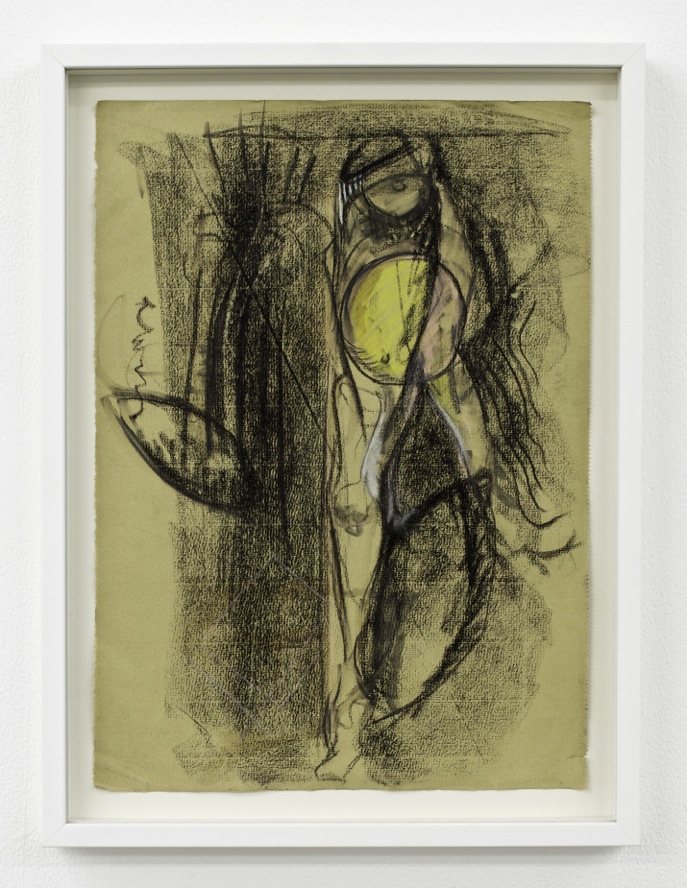
© » KADIST
Anne Imhof
Drawing & Print (Drawing & Print)
“School of the seven Bells (SOTSB)” is based on a series of hands games in which an object is passed from hand to hand. The performance is a reference to the film by Robert Bresson, “Pickpocket”, where a group of pickpocketers play with their victims. The artwork, through the actions of the hands, is an interrogation into space and time, questioning the relationship between public and private space, the establishment of communication through the body and visual exchange and gestures between aggression and sensuality.

© » KADIST
Anne Imhof
Anne Imhof’s video work Untitled (Wave) creates resonances between the feminine, adoration, and immateriality, while also referring to the history of art and aesthetics, in particular the concept of the sublime. Starring Imhof’s partner and collaborator Eliza Douglas, the film depicts a woman, naked from the waist up, dressed simply in tracksuit trousers, long black hair, feet dipped in the ocean water. The woman bears a long whip, while she looks out at the horizon and the waves lick at her bare feet.

© » KADIST
Anna Molska
Perspective was filmed during a residence in northern Poland. The film is preceded by a series of photographs made ? ?in her studio.

© » KADIST
Ana Vaz
Há Terra! (There Is Land!) is a short film by Ana Vaz that picks up on the artist’s previous film A Idade da Pedra (2013), in which Vaz imagined premodernity in her native Brazil.

© » KADIST
Anna Boghiguian
In the painting called “The Consciousness of Memory, Time, and Guilt” as in many of her recent works, the body is fragmented. The brain, the ear, the eyes, these body parts that put us in relation with the other and link the visible to the invisible, remain isolated. Whereas the skulls are joined by lines evoking rivers.

© » KADIST
Anne Samat
Anne Samat’s Puteri 3 references Ulek Mayang, a classical Malay dance, performed in a ritualistic pre-Islamic context. It is based on the myth of a princess from the sea who steals the soul of a fisherman she falls in love with, leaving his body lifeless. A battle ensues for the soul of the fisherman, between a shaman (bomoh) trying to bring back the spirit into the earthly flesh and the princess aided by five of her sisters.
Andrew Norman Wilson
Andrew Norman Wilson is an artist, curator, and filmmaker whose practice is mostly based in research and documentary...
Yee I-Lann
- location: Kuala Lumpur, Malaysia
- year born: 1971
- gender: female
- nationality: Malaysian
- home town: Sabah, Malaysia
Jordan Kantor
Jordan Kantor’s artworks explore relationships between painting and photographic mediums...
Douglas Gordon
- location: Berlin, Germany
- year born: 1966
- gender: male
- nationality: Scottish
- home town: Glasgow, United Kingdom
Chantal Edie and Zacharie Ngnogue
Chantal Edie and Zacharie Ngnogue are a photography duo who channel their personal experiences into social commentaries...
Leung Chi Wo and Wong Sara
Leung Chi Wo tends to highlight in his art the boundaries between viewing and voyeurism, real and fictional, and art and the everyday...
Richard Gordon
Originally from Chicago, Richard Gordon was a self-taught photographer best known for his intelligent and masterfully printed black-and-white photographs...
John Wood and Paul Harrison
John Wood and Paul Harrison have been working collaboratively since 1993, producing single screen and installation-based video works...
An-My LE
- location: New York, New York
- year born: 1960
- gender: female
- home town: Saigon, Vietnam
Ana Vaz
Ana Vaz is an artist and filmmaker whose works speculate on the relationships between self and other, and myth and history, through a cosmology of signs, references, and perspectives...
Slavs and Tatars
Self-described as an “Eurasian-based” collective, Slavs and Tatars investigates the “polemics and intimacies” of the region “east of the former Berlin Wall and west of the Great Wall of China” or Caucasia...
Ho Rui An
The artist, writer, and researcher Ho Rui An probes histories of globalization and governance, performing a detournement of dominant semiotic systems across text, film, installation, and lecture...
Nan Goldin
- year born: 1953
- gender: female
- nationality: American
- home town: Washington, D.C.
Mary Ann Aitken
Mary Ann Aitken was known to be very private about her art practice; she was considered somewhat of an outsider by her peers affiliated with the second wave of Detroit’s Cass Corridor arts movement...
Donna Conlon and Jonathan Harker
- location: Panama City, Panama
- year born: 1966
- nationality: American and Ecuadorian
Jay Chung and Takeki Maeda
Jay Chung and Takeki Maeda’s practice is characterized by performance, which often involves weighty unsettling humour...
Pauline Boudry and Renate Lorenz
Working together since 2007, artist duo Pauline Boudry and Renate Lorenz conduct research on the heritage of cultural and gender studies, concentrating primarily on gender discourses and the notion of queer...
Michael Craig-Martin
Michael Craig-Martin studied fine art at Yale University returning to Europe in the mid-1960s and becoming one of the key figures in the first generation of British conceptual artists...
Lenka Clayton and Phillip Andrew Lewis
Lenka Clayton and Phillip Andrew Lewis’s collaborative practice is social at its core: it engages with and connects communities outside of the so-called art world in both production and presentation...
Michelle and Noel Keserwany
Michelle and Noël Keserwany compose and perform their own songs, as well as contribute to the illustrations and animations featured in the videos they produced...
John Lucas and Claudia Rankine
John Lucas and Claudia Rankine are interdisciplinary thinkers and makers committed to exploring the nuances of race and power in our daily lives...
Angela Detanico and Rafael Lain
Linguists, semiologists, and graphic designers by training, Angela Detanico and Raphaël Lain consider the use of graphic signs in society...
Etel Adnan and Lynn Marie Kirby
Visual artist, poet, and essayist Etel Adnan writes what must be communicated through language, and paints what cannot...
Anna Molska
Anna Molska uses video performance to explore the effect of artistic culture on the production of art...
Musquiqui Chihying and Gregor Kasper
Through his artistic career, Musquiqui Chihying has striven to dislocate and reconstruct established modes of behavior within systems and structures of power...
Anna Boghiguian
Anna Boghighian makes drawings and paintings of individuals and urban spaces as well as being a writer and a poet...
Anne Samat
An exuberant and precise sculptor, Anne Samat blends the aesthetic of international queer cultures – which she proudly represents as a transgender activist – with various textile and bricolage influences from South East Asia and beyond...
Jordan Ann Craig
Jordan Ann Craig is a Northern Cheyenne artist born and raised in the Bay Area; she invests her work with a strong interest in Indigenous culture and the history of its destruction by settlers...
Maayan Amir and Ruti Sela
Maayan Amir and Ruti Sela, two young Israeli women artists work collaboratively or individually by project...

© » APERTURE
about 5 months ago (12/01/2023)
For the past two decades, An-My Lê has used photography to examine her personal history and the legacies of US military power, probing the tension between experience and storytelling....

© » LARRY'S LIST
about 14 months ago (03/01/2023)
CIRCA collaborates with Anne Imhof to present #YOUTH24 - a 24-hour print fundraiser...
-
1980-1989
Jean-Marie Straub and Danièle Huillet
1982En rachâchant is based on the short story Ah! Ernesto! (1971) by Marguerite Duras in which the child Ernesto does not want to go to school anymore as all that he is taught are things he does not know...
-
1990-1999
Douglas Gordon
1996In Monster (1996-97), the artist’s face becomes grotesque through the application of strips of transparent adhesive tape, typical of Gordon’s performance-based films that often depict his own body in action...
John Wood and Paul Harrison
1996One of John Wood and Paul Harrison’s earliest works, Device features Harrison performing a series of actions, assisted by the titular ‘devices’, that use physics to force his body into unusual and uncomfortable positions...
John Wood and Paul Harrison
19973-Legged is an early video work by John Wood and Paul Harrison in which they appear with their legs tied together (as one would do in a three-legged race)...
-
2000-2009
Douglas Gordon
2002Blind Spencer is part of the series “Blind Stars” including hundreds of works in which the artist cut out the eyes of Hollywood stars, in a symbolically violent manner...
Mary Ann Aitken
2002Untitled (Boom Box, Double-Sided) by Mary Ann Aitken is representational painting of a boom box on an unconventionally long canvas painted on both sides, to mimic the scale and appearance of the actual appliance...
Richard Gordon
2003San Francisco, Moscone Center is a silver gelatin print from the series American Surveillance , a ten-year-long project where Richard Gordon photographed surveillance cameras across USA...
Maayan Amir and Ruti Sela
2003In Beyond Guilt the two artists create a portrait of our generation in three parts...
Jordan Wolfson
2004Dreaming of the dream of the dream is a 16mm projection consisting of images of waves that come and go continuously...
Douglas Gordon
2004Douglas Gordon’s single-channel video The Left Hand Can’t See That The Right Hand is Blind, captures an unfolding scene between two hands in leather gloves—at first seemingly comfortable to be entwined, and later, engaged in a struggle...
Jordan Kantor
2008Lens Flare and the series Untitled Basel Lens Flare (6168, 5950, 7497) were part of a solo project by the artist presented at ArtBasel in 2009...
Jordan Kantor
Drawing & Print
2009(Drawing & Print) Eclipse is a series of screenprints from Jordan Kantor’s larger vitrine installation that included reworkings of a single image of a small group viewing an eclipse through shielding cut-outs...
Jordan Kantor
2009Lens Flare and the series Untitled Basel Lens Flare (6168, 5950, 7497) were part of a solo project by the artist presented at ArtBasel in 2009...
Mary Ann Aitken
2009Untitled (Diptych) by Mary Ann Aitken is a pair of paintings; one entirely abstract and the other a hybrid of representational and abstract elements...
Pauline Boudry and Renate Lorenz
2009Salomania sees choreographer and filmmaker Yvonne Rainer and artist Wu Tsang rehearse scenes from Valda’s Solo , a chapter of a film Rainer made in 1972 after having seen women perform the dance of the seven veils in Alla Nazimova’s 1923 silent film Salomé ...
Jay Chung and Takeki Maeda
2009Jay Chung and Q Takeki Maeda remake a clip from the 1970s they found on the internet, and without really changing this archive material, displace it by imitating the staging and the acting with scrupulous precision...
-
2010-2019
Olive Martin and Patrick Bernier
2010The Mohawk, the emblematic Frontier river in the period of American colonisation, is here a cable of data transmission, and the 7 Sultans Casino is a virtual destination, one of the three hundred online casinos hosted by the servers located in Kahnawake, a small native american indian reserve to the south of Montreal...
The Propeller Group and Superflex
2010Fade In (the whole title of the film is actually the entire five page script) is a collaboration with the Danish artist collective Superflex (group of freelance artist–designer–activists committed to social and economic change, founded in 1993 by Jakob Fenger, Rasmus Nielsen and Bjørnstjerne Christiansen)...
Leung Chi Wo and Wong Sara
2010Office Lady with a Red Umbrella restages a figure from a 1980 postcard made from a photograph from 1950’s...
An-My LE
2010The print Patient Admission, US Naval Hospital Ship Mercy, Vietnam (2010) features an Asian Buddhist monk and an American Navy Solider on board the Mercy ship –one of the two dedicated hospital ships of the United States Navy– sitting upright in their chairs and adopting the same posture...
Võ An Khánh
2010In Extra Curriculum Political Science Class 7/1972 , a group of women walk bare-foot and single file towards Dat Mui Mangrove in Ca Mau Province to attend ‘political science class’...
Jane Jin Kaisen and Guston Sondin-Kung
2010The Woman, The Orphan, and The Tiger begins with the sound of women’s voices describing histories of violence, of things repressed and silenced...
Leung Chi Wo and Wong Sara
2010Photojournalist with Two Cameras restages a portrait of a photojournalist from the background of an old photograph of protest published in South China Morning Post on January 10, 2010 under the headline “Return of the Radicals: Recent angry protests are nothing new.” The photojournalist in the photograph, probably from a protest of earlier decades, was capturing the scene of a protester’s arrest while wearing two cameras...
Ana Teresa Fernández
Drawing & Print
2011(Drawing & Print) The artist writes about her work Borrando la Frontera, a performance done at Tijuana/San Diego border: “I visually erased the train rails that serve as a divider between the US and Mexico...
Ei Arakawa and Sergei Tcherepnin
2011Part of a series entitled “Looking at Listening”, 2011, the piece invited the spectator to experiment and consider sound as a kinetic and synesthetic process, where multiple experiences and senses can cross...
Tun Win Aung and Wah Nu
2011Tun Win Aung and Wah Nu initiated the series 1000 Pieces (of White) in 2009, as a way to produce objects and images as a portrait of their shared life as partners and collaborators...
Ana Roldán
2012Ana Roldán’s Primeval forms series looks up close at the fecund shapes of plants often found in the artist’s native Mexico...
Ana Roldán
2012Ana Roldán’s Displacements works use images taken from a 1970s exhibition catalogue for an exhibition called The Death in Mexico...
Leah Gordon
2012The Caste Portraits Series by Leah Gordon investigates the practice of grading skin color from black to white, which marked the extent of racial mixing in 18th century Haiti...
Donna Conlon and Jonathan Harker
2012In Tapitapultas (2012), Donna Conlon and Jonathan Harker comment on mass consumerism and pollution by way of a game they invented...
Anne Imhof
Drawing & Print
2013(Drawing & Print) “School of the seven Bells (SOTSB)” is based on a series of hands games in which an object is passed from hand to hand...
Anna-Bella Papp
2013Untitled exemplifies the format that Anna Bella-Papp most commonly works in, using her hands to create delicate tablet-like reliefs within a rectangular form made out of clay...
Yee I-Lann
2013Sarcastically titled to call attention to the problematic notions underlying colonialism, this photograph shows hundreds of Native Malaysians seated quietly behind one of their colonial oppressors...
Andrew Norman Wilson
2014Chase ATM emitting blue smoke, Bank of America ATM emitting red smoke, TD Bank ATM emitting green smoke was shot in the American Southwest at Mid-century modern architectural structures that were built to house regional independent banks and have since been bought up by Chase, Bank of America, and TD Bank...
Anna Boghiguian
2014In the painting called “The Consciousness of Memory, Time, and Guilt” as in many of her recent works, the body is fragmented...
Gabriella and Silvana Mangano
2015There is no there by Gabriella and Silvana Mangano is a black and white looped video with sound, in conjunction with a live performance...
João Maria Gusmão and Pedro Paiva
2015The artist duo João Maria Gusmão and Pedro Paiva traveled to Japan for a month to make a series of short 16mm films, often shot in slow-motion...
Christine Sun Kim and Thomas Mader
2016Indexes that either allow or inhibit the establishment of communication exist in both signed as well as spoken languages...
Etel Adnan and Lynn Marie Kirby
Drawing & Print
2017(Drawing & Print) In conjunction with KADIST’s 2017 exhibition If Not Apollo, the Breeze , artist and filmmaker Lynn Marie Kirby performed Transmissions , a video and live reading created with longtime collaborator Etel Adnan...
Anne Samat
2018Anne Samat’s Puteri 3 references Ulek Mayang, a classical Malay dance, performed in a ritualistic pre-Islamic context...
John Lucas and Claudia Rankine
Drawing & Print
2018(Drawing & Print) Historically, blondeness has been a signifier for desirability and beauty, speaking to “purity” — the purity of whiteness — like no other bodily attribute except, perhaps, blue eyes...
Pooja Gurung and Bibhusan Basnet
2018DADYAA: The Woodpeckers of Rotha by Pooja Gurung and Bibhusan Basnet illuminates a unique and seldom seen international perspective on indigenous cultures and contemporary social issues in the Nepali context...
Jordan Ann Craig
2019Something To Do With Being Held by Jordan Ann Craig is inspired by a Cheyenne bead bag...
Andrew Norman Wilson
2019In Andrew Norman Wilson’s work Kodak the artist uses computer-generated imagery to create narratives that question the reliability of images in the age of post-production...
Ana María Millán
2019Interested in role-play and videogames, Ana María Millán developed workshops with different communities in order to create characters and scenarios for her animations, often in collaboration with a choreographer...
Musquiqui Chihying and Gregor Kasper
2019Addressing the legacy of colonialism, The Guestbook by Musquiqui Chihying and Gregor Kasper is a slow-paced, black-and-white film exploring the German colony of Togoland, now the Republic of Togo...
-
2020-2029
Andrew Norman Wilson
2020Z = |Z/Z•Z-1 mod 2|-1: Lavender Town Syndrome by Andrew Norman Wilson is a multi-channel video that uses three different imaging technologies—a photographic lens, photorealistic ray tracing animations, and fractal ray-marching animations—to travel through three constructed environments...
Andrew Norman Wilson
2020On the first day of the Covid-19 lockdown in New York, Andrew Norman Wilson was evicted from his sublet and decided to board a $30 flight to Los Angeles that evening...
Yee I-Lann
20207-headed Lalandau Hat by Yee I-Lann is an intricately woven sculpture evoking the ceremonial headdress worn by Murut men in Borneo...
Chantal Edie and Zacharie Ngnogue
2020Au non de la liberté (Tiko drink Kumba drunk) is a photographic series by Zacharie Ngnogue and Chantal Edie that considers the correlation between those who hold power in Cameroon and how their actions affect the populations they rule in often compromising ways...
Chantal Edie and Zacharie Ngnogue
2020Au non de la liberté (Tiko drink Kumba drunk) is a photographic series by Zacharie Ngnogue and Chantal Edie that considers the correlation between those who hold power in Cameroon and how their actions affect the populations they rule in often compromising ways...
Chantal Edie and Zacharie Ngnogue
2020Au non de la liberté (Tiko drink Kumba drunk) is a photographic series by Zacharie Ngnogue and Chantal Edie that considers the correlation between those who hold power in Cameroon and how their actions affect the populations they rule in often compromising ways...
Anne Imhof
2021Anne Imhof’s video work Untitled (Wave) creates resonances between the feminine, adoration, and immateriality, while also referring to the history of art and aesthetics, in particular the concept of the sublime...
Jonas Van and Juno B
2021Jonas Van and Juno B’s video work Kebranto is anchored by the figure of Boitatá, a snake that is part of the imaginary Guaraní communities that live between the current nation-states of Argentina, Brazil, Paraguay, and Uruguay...
Ana Vaz
2022Ana Vaz describes her film É Noite na América (It is Night in America) as an eco-terror tale, freely inspired by A cosmopolitics of animals by Brazilian philosopher Juliana Fausto; in which she investigates the political life of non-human beings and questions the modern idea of the exceptionality of the human species...
Michelle and Noel Keserwany
2022Les Chenilles by Michelle and Noël Keserwany is a sensual film that translates the source of women’s oppression into the means for their liberation...
Miguel and Natalia Fernández de Castro and Mendoza
2022The Absolute Restoration of All Things is a collaboration by artist Miguel Fernández de Castro and anthropologist Natalia Mendoza...
Köken Ergun and Satyam Mishra
2022Nepal and China signed an agreement for the Belt and Road Initiative (BRI) in 2017...
Köken Ergun and Tashi Lama
2022Nepal and China signed an agreement for the Belt and Road Initiative (BRI) in 2017...
Köken Ergun and Satyam Mishra
2022Nepal and China signed an agreement for the Belt and Road Initiative (BRI) in 2017...
Lenka Clayton and Phillip Andrew Lewis
2022Five Hundred Twenty-Four, a single-channel video installation by Lenka Clayton and Phillip Andrew Lewis, features singers from over twenty Cleveland-area choirs counting numbers in an iterative process: one person sings “one”, then two people sing “two”, and so forth, to 524...










